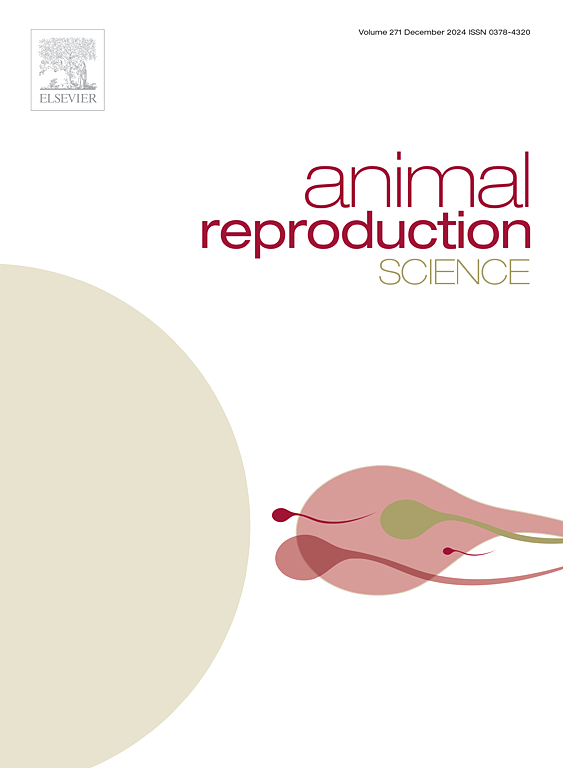短期补充瘤胃保护性叶酸对荷斯坦奶牛妊娠率、单碳代谢和类固醇激素的影响
IF 2.2
2区 农林科学
Q1 AGRICULTURE, DAIRY & ANIMAL SCIENCE
引用次数: 0
摘要
本试验旨在研究饲粮中添加保护瘤胃叶酸(RPFA)对奶牛首次人工授精妊娠率和代谢参数的影响。根据胎次、平均日产奶量、泌乳天数和体况评分对256头多产荷斯坦奶牛进行分组,随机分为4个处理:奶牛每天口服0、3、6或9 g RPFA。RPFA饲喂时间为50 ± 3 d,饲喂后36 d。补充RPFA对妊娠初期妊娠率无显著影响。比较3 g RPFA组与对照组血浆和卵泡液中叶酸代谢、单碳代谢和类固醇激素浓度。添加3 g RPFA的奶牛血浆中叶酸、5-甲基四氢叶酸(5-MTHF)、s -腺苷蛋氨酸和亚叶酸蛋白浓度较高,同型半胱氨酸和对氨基苯甲酰谷氨酸含量降低。单碳代谢分析显示,3 g RPFA的供应增加了卵泡液中叶酸和5-MTHF的浓度。同时,3 g RPFA组奶牛血浆雌二醇浓度升高,血浆和卵泡液雄烯二酮浓度降低。体外给药50 μM的叶酸可增强颗粒细胞中CYP19A1基因的表达。这些结果表明,在发情同步期间,短期补充RPFA不影响首次妊娠率,它降低了血浆同型半胱氨酸水平,但不改变卵泡液同型半胱氨酸浓度。此外,RPFA补充与类固醇激素调节的变化有关,尽管需要进一步的研究来调查潜在的机制。本文章由计算机程序翻译,如有差异,请以英文原文为准。
Effects of short-term rumen-protected folic acid supplementation on pregnancy rate, one-carbon metabolism, and steroid hormone in Holstein dairy cows
This study investigated the effects of rumen-protected folic acid (RPFA) supplementation on pregnancy rate at first artificial insemination (AI) and metabolic parameters in dairy cows. A total of 256 multiparous Holstein dairy cows were blocked by parity, average daily milk yield, days in milk, and body condition scores, and then randomly assigned to 1 of 4 treatments: cows were orally given 0, 3, 6, or 9 g RPFA per day. RPFA feeding was started from 50 ± 3 days in milk through 36 days post-timed AI. Pregnancy rate at first-AI was not significantly affected by RPFA supplementation. Comparisons of folic acid metabolism, one-carbon metabolism, and steroid hormone concentration in both blood plasma and follicular fluids were carried out between 3 g RPFA group and control. Cows supplemented with 3 g RPFA had greater plasma concentrations of folic acid, 5-methyltetrahydrofolate (5-MTHF), S-adenosylmethionine, and leucovorin, while reduced homocysteine and p-aminobenzoylglutamate. One-carbon metabolic analysis showed 3 g RPFA supply increased folinic acid and 5-MTHF concentrations in follicular fluids. Meanwhile, cows in 3 g RPFA group had elevated plasma estradiol concentration, while decreased androstenedione in both plasma and follicular fluids. Enhanced CYP19A1 gene expression in granulosa cells was examined when supplied with 50 μM folic acid in vitro. These findings indicated that the pregnancy rate at first-AI were not affected by short-term RPFA supplementation during the estrus synchronization period, it reduced plasma homocysteine levels without altering follicular fluid homocysteine concentrations. Additionally, RPFA supplementation was associated with changes in steroid hormone regulation, although further studies are needed to investigate the underlying mechanisms.
求助全文
通过发布文献求助,成功后即可免费获取论文全文。
去求助
来源期刊

Animal Reproduction Science
农林科学-奶制品与动物科学
CiteScore
4.50
自引率
9.10%
发文量
136
审稿时长
54 days
期刊介绍:
Animal Reproduction Science publishes results from studies relating to reproduction and fertility in animals. This includes both fundamental research and applied studies, including management practices that increase our understanding of the biology and manipulation of reproduction. Manuscripts should go into depth in the mechanisms involved in the research reported, rather than a give a mere description of findings. The focus is on animals that are useful to humans including food- and fibre-producing; companion/recreational; captive; and endangered species including zoo animals, but excluding laboratory animals unless the results of the study provide new information that impacts the basic understanding of the biology or manipulation of reproduction.
The journal''s scope includes the study of reproductive physiology and endocrinology, reproductive cycles, natural and artificial control of reproduction, preservation and use of gametes and embryos, pregnancy and parturition, infertility and sterility, diagnostic and therapeutic techniques.
The Editorial Board of Animal Reproduction Science has decided not to publish papers in which there is an exclusive examination of the in vitro development of oocytes and embryos; however, there will be consideration of papers that include in vitro studies where the source of the oocytes and/or development of the embryos beyond the blastocyst stage is part of the experimental design.
 求助内容:
求助内容: 应助结果提醒方式:
应助结果提醒方式:


